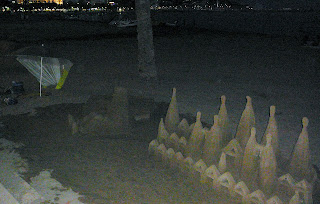Bays and their peninsulas on the side make perfect settlement spots. The trouble is, once one group sets up shop, another casts a covetous eye on it, and the warfare begins. At Roses, with its Bay of Roses, evidence of settlements BCE (Greek) through Roman, through more Greek (from the Marseilles area), and Visigoths, and the monastery at Santa Maria de Roses arises in about 944 CE.
The monastery is at the end of this side of the bay's peninsula.
She went in. Is she still out there?
In
this heat wave, we did not shop around for restaurants, and the hotels
were all crowded. Find an elevated deck area, breeze if any, outside in
the shade, and just sit and eat bits after bits, until darkness comes
and all cools off. Serious meals start at 8PM at the earliest. Tapas any time, and is enough to satisfy.
For those of us without reservations, arriving at a fine resort late in the day means taking what you can get. Go to the tourist office and they will call around. We found two rooms, separate, at the local hostel, Rom Hostel. Hot, but that is not their fault. Aim the fan and stay still. Dan got over-hot and was too polite to bang on my door -- now he knows to knock a little louder and announce reasonably that it is indeed he, and I would awaken mejitly.
Note on bad economic times and hostels: entire families, and many, many older people, were at the Rom. This was not just full of backpacking kids. A hostel may be the only way to afford some time at the beach. Safe, clean, friendly.
Sleeping at hostel. The possibility of hostels means sleeping gear that doubles for street-wear, for going to the loo/shower down the hall. I use a black T-shirt dress for sleeping, Dan sleeps in shorts. That also saves on packing. If two of you accept a room for four, expect two more to join you. If you take a room for 1, you will get more privacy but it may be hotter. Trade.
 Roses, Spain. Costa Brava. Castle ruin at peninsula.
Roses, Spain. Costa Brava. Castle ruin at peninsula. Roses, Spain. Discreet photo, topless lady
Roses, Spain. Discreet photo, topless lady Daniel Widing, pleased to be at Roses, Spain. Costa Brava.
Daniel Widing, pleased to be at Roses, Spain. Costa Brava.  Roses, Spain. People-watching.
Roses, Spain. People-watching. Roses, Spain. Good food, even at places with pictures out there.
Roses, Spain. Good food, even at places with pictures out there. Roses, Spain. Nighttime sandcastles. Show appreciation with some change.
Roses, Spain. Nighttime sandcastles. Show appreciation with some change.  Citadel of Roses, Spain. Walkway past old Greek and Roman ruins.
Citadel of Roses, Spain. Walkway past old Greek and Roman ruins. Citadel at Roses, Ciutadella de Roses, walled structures within walled structures
Citadel at Roses, Ciutadella de Roses, walled structures within walled structures Citadel of Roses, Spain. Strategic location.
Citadel of Roses, Spain. Strategic location. Citadel of Roses, Spain. Ruins of old barracks.
Citadel of Roses, Spain. Ruins of old barracks.
 Roses Citadel. Ciudadela. Successive conquerors and settlers built here.
Roses Citadel. Ciudadela. Successive conquerors and settlers built here. Citadel, Roses, Spain. Parade ground. Huge enclosed fortified pentagon, star shaped.
Citadel, Roses, Spain. Parade ground. Huge enclosed fortified pentagon, star shaped. Empuries, Spain. Greeks and Romans by the sea.
Empuries, Spain. Greeks and Romans by the sea. Empuries, Costa Brava, Spain. Ancient town layout; archeology site.
Empuries, Costa Brava, Spain. Ancient town layout; archeology site. Ruines d'Empuries, Costa Brava. Ancient heritage.
Ruines d'Empuries, Costa Brava. Ancient heritage. Empuries, Roman wall, Spain
Empuries, Roman wall, Spain  Empuries, Spain. Roman mosaics and tiling
Empuries, Spain. Roman mosaics and tiling
 Dan Widing high-fives at the Empuries interactive museum, Costa Brava, Spain
Dan Widing high-fives at the Empuries interactive museum, Costa Brava, Spain Empuries, Dan Widing with Good Samaritan who unlocked the steering wheel.
Empuries, Dan Widing with Good Samaritan who unlocked the steering wheel.  Costa Brava, Spain
Costa Brava, Spain Sant Feliu, Benedictine Monastery, Costa Brava, Spain
Sant Feliu, Benedictine Monastery, Costa Brava, Spain San Feliu, ruins of earliest Benedictine monastery, Costa Brava, Spain
San Feliu, ruins of earliest Benedictine monastery, Costa Brava, Spain Sant Pere Pescador, Figueres, Spain
Sant Pere Pescador, Figueres, Spain Benedict's Arch, 18th century, Benedictine Monastery, Sant Feliu de Guixols, Costa Brava, Spain
Benedict's Arch, 18th century, Benedictine Monastery, Sant Feliu de Guixols, Costa Brava, Spain Palamos, Spain. Breakfast at the Saint Joan Part I
Palamos, Spain. Breakfast at the Saint Joan Part I Palamos, Spain, Costa Brava, Breakfast at the Saint Joan, Part II
Palamos, Spain, Costa Brava, Breakfast at the Saint Joan, Part II Palamos, Spain. Breakfast at the Hotel Saint Joan, Part III
Palamos, Spain. Breakfast at the Hotel Saint Joan, Part III Palamos, Spain. Hotel Cat.
Palamos, Spain. Hotel Cat. Palamos, Spain. Marina.
Palamos, Spain. Marina. Palamos, Spain, One family's house.
Palamos, Spain, One family's house. Leaving Palamos, near Begur, Spain. Another family's house.
Leaving Palamos, near Begur, Spain. Another family's house. Montgri Castle, Spain.
Montgri Castle, Spain. Catherine of Aragon, Royal Doulton
Catherine of Aragon, Royal Doulton Tossa de Mar, Spain. Walled, medieval city. Costa Brava.
Tossa de Mar, Spain. Walled, medieval city. Costa Brava. Tossa de Mar, Spain. Ready refuge on the beach, Costa Brava.
Tossa de Mar, Spain. Ready refuge on the beach, Costa Brava. Tossa de Mar, Spain. Street, medieval city.
Tossa de Mar, Spain. Street, medieval city. Dan Widing meets Ava Gardner at Tossa de Mar, Spain. Why is she there?
Dan Widing meets Ava Gardner at Tossa de Mar, Spain. Why is she there? Blanes, Costa Brava, Spain. Beach.
Blanes, Costa Brava, Spain. Beach.